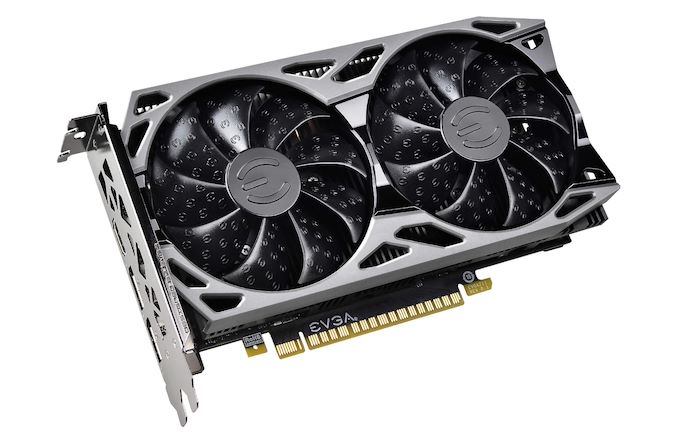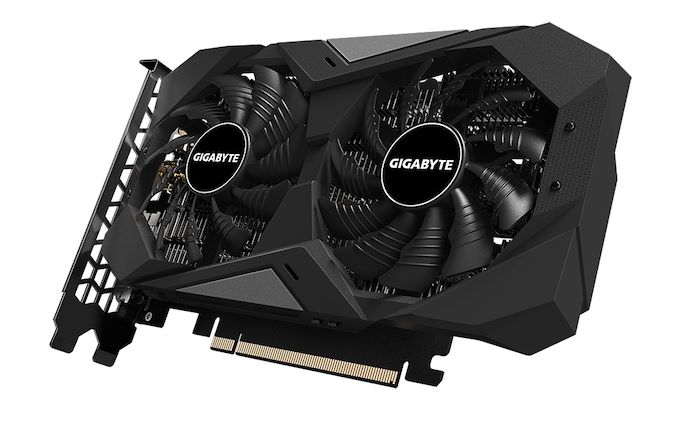NVIDIA’s GeForce GTX 1650 GDDR6 Released: GDDR6 Reaching Price Parity With GDDR5
by Ryan Smith on April 6, 2020 10:00 AM EST
Tucked inside NVIDIA’s announcement of their spring refresh of their mobile GPU lineup, the company included a new low-end mobile part, the GeForce GTX 1650 GDDR6. Exactly as it says on the tin, this was a version of the company’s GTX 1650 accelerator, except with newer GDDR6 instead of the GDDR5 it launched with. Now, in one of NVIDIA’s more poorly kept secrets, their desktop product stack is getting a version of the card as well.
While not a launch (as NVIDIA likes to frame it), the desktop GTX 1650 GDDR6 has none the less finally become an official product this past Friday, with partners unveiling their cards and NVIDIA adding the specifications to their website. Sitting alongside the existing GDDR5 version, the GDDR6 version is intended to be a parallel, generally equal SKU. As NVIDIA makes the transition from GDDR5 to GDDR6 at the bottom edge of their product lineup, the updated card gets access to faster memory, but interestingly the GPU clockspeeds are also tapered back a bit.
| NVIDIA GeForce Specification Comparison | ||||||
| GTX 1660 | GTX 1650 Super | GTX 1650 (G6) | GTX 1650 (G5) | |||
| CUDA Cores | 1408 | 1280 | 896 | 896 | ||
| ROPs | 48 | 32 | 32 | 32 | ||
| Core Clock | 1530MHz | 1530MHz | 1410MHz | 1485MHz | ||
| Boost Clock | 1785MHz | 1725MHz | 1590MHz | 1665MHz | ||
| Memory Clock | 8Gbps GDDR5 | 12Gbps GDDR6 | 12Gbps GDDR6 | 8Gbps GDDR5 | ||
| Memory Bus Width | 192-bit | 128-bit | 128-bit | 128-bit | ||
| VRAM | 6GB | 4GB | 4GB | 4GB | ||
| Single Precision Perf. | 5 TFLOPS | 4.4 TFLOPS | 2.85 TFLOPS | 3 TFLOPS | ||
| TGP | 120W | 100W | 75W | 75W | ||
| GPU | TU116 (284 mm2) |
TU116 (284 mm2) |
TU117 (200 mm2) |
TU117 (200 mm2) |
||
| Transistor Count | 6.6B | 6.6B | 4.7B | 4.7B | ||
| Architecture | Turing | Turing | Turing | Turing | ||
| Manufacturing Process | TSMC 12nm "FFN" | TSMC 12nm "FFN" | TSMC 12nm "FFN" | TSMC 12nm "FFN" | ||
| Launch Date | 03/14/2019 | 11/22/2019 | 04/03/2020 | 04/23/2019 | ||
| Launch Price | $219 | $159 | ~$149 | $149 | ||
By the numbers, the new GDDR6 version is largely the same as the GDDR5 version. Both are 75W cards based on NVIDIA’s entry-level Turing TU117 GPU. However the GDDR6 version of the card both gains some and loses some in the process. NVIDIA swaps out the GDDR5 for newer GDDR6 – and thereby finally confirming that TU117 is GDDR6-capable – however the cards also take a slight clockspeed nerf. As a result the GDDR6 version of the card has a whopping 50% more memory bandwidth – bringing it to 192GB/sec – but 5% lower GPUs clocks and throughput.
In discussing the matter with NVIDIA, we were told that the GPU clockspeed change was to equalize performance and power consumption between the two parts. Which makes sense to a degree – the GTX 1650 is a particularly special part in NVIDIA’s lineup since it’s the fastest card they offer that can be powered entirely by a PCIe slot, which is to say it can’t have a TDP over 75 Watts. So with the GDDR5 version already close to that limit, if the switch to GDDR6 memory drives up power consumption at all (be it the memory or the GPU’s memory controllers), then something else has to be dialed back to compensate.
Meanwhile, equalizing performance is something of a secondary goal in this situation, especially because of the potency of GDDR6 memory. NVIDIA doesn't intend for the GDDR6 version of the GTX 1650 to be its own product; the next card up after the GTX 1650 remains the GTX 1650 Super. But given what we’ve seen on other Turing parts such as the GTX 1660 series, where a similar switch netted a further 10% in performance, I would expect the GTX 1650 to see the same kind of modest benefits from the faster memory. This in turn would more than outweigh the 5% GPU clockspeed drop. So don’t be surprised if the GTX 1650 with GDDR6 turns out to be a bit faster than its pre-existing GDDR5 counterpart, though it shouldn’t be by very much.
Otherwise, the GTX 1650 GDDR6 will end up filling the same general role as the original GTX 1650. The entry-level card is the cheapest (and the slowest) of the Turing family, offering as much performance as NVIDIA can pack into a 75 Watt TDP. And while the cards should still be relatively small, I do find it interesting that NVIDIA lists the length for the (non-public) reference card at 5.7-inches, 0.6-inches longer than the GDDR5 version. GDDR6 cards require a new PCB, so this raises the curious question of whether GDDR6 designs can’t be made quite as compact as GDDR5 designs.
Overall, this low-key release should mark a more important turning point in the state of GDDR memory. If NVIDIA and its partners are now willing to release GDDR6 versions of low-end cards, then this is a strong indicator that GDDR6 has finally lost most of its new technology price premium, and that memory prices have fallen by enough to be competitive with 8Gbps GDDR5. GDDR6 prices were a sticking point for the profit-sensitive NVIDIA during the original Turing product stack launch, so while it has taken an extra year, the company is finally offering a top-to-bottom GDDR6-based product stack.
NVIDIA’s partners, in turn, are already rolling out their cards, with designs from Gigabyte, MSI, EVGA, and others. As with the original GTX 1650 cards, it looks like many of these will be factory overclocked, throwing out the 75W power limit in order to get some extra performance out of the TU117 GPU. Meanwhile, pricing for the GDDR6 cards appears to be identical to their GDDR5 counterparts, underscoring the transitionary nature of this release.
Source: NVIDIA











30 Comments
View All Comments
wizfactor - Monday, April 6, 2020 - link
I don' think there's anything wrong with getting a rig with some style over substance. I personally own a small form-factor PC case that's premium as hell, but I love it to death.With all of that said, of all the things to cheap out on in the name of chasing RGB fans, the PSU should be last. Of all the components in a system, the PSU is the most likely to be a literal fire hazard, so everybody should go out of their way to get one that's at least built to acceptable standards. Any decent PSU will be good enough to power the 1650 Super, so it's basically impossible to argue that a PC build "must" use the 1650 over the Super for PCIe power reasons.
Holliday75 - Monday, April 6, 2020 - link
The people making decisions on this type of gear are looking at thousands of units, possible tens of thousands. Cost changes that are difficult to quantify are not overlooked.Retycint - Monday, April 6, 2020 - link
Same reason why many business laptops are configured with crappy 768p TN screens, because apparently cheaper is better, yet not considering the loss of productivity from using such a low res screen (less screen real estate as things are inflated etc)eek2121 - Monday, April 6, 2020 - link
This is a retail channel part, not OEM.DanNeely - Tuesday, April 7, 2020 - link
The cards illustrating the article are retail, but with GDDR5 being discontinued blander looking OEM cards will be switching over as well. There might be a delay, if GDDR5 is marginally cheaper some OEMs might've made large last orders of it because in their market $5 savings on the BOM is more important than 5% higher FPS, but even there their stock of GDDR5 cards will eventually run out. They won't want to stockpile too many since next generation cards will be coming out at some point in the future.shabby - Monday, April 6, 2020 - link
Gotta milk the cow.Yojimbo - Monday, April 6, 2020 - link
Pricing isn't based on "fairness", it's based on the market. Sellers are always trying to maximize their profit, and the pricing gets set by what people are willing to pay and the cost dependencies of the products. Your judgment of what is fair or not may or may not match with the demands of the market or the cost dependencies of the production of the products. Now, NVIDIA may bin their products in a way that doesn't match the demand of the market very well, but that's just a matter of making inefficient decisions and not a matter of "fairness".Yojimbo - Monday, April 6, 2020 - link
We need to do a better job of educating people the way markets work as well as the way statistics work. We are doing a great disservice to ourselves as a society if we don't have good education in these areas because people who have an inaccurate idea make bad decisions and can be more easily fooled and taken advantage of.PeachNCream - Tuesday, April 7, 2020 - link
If you did educate people at large about that, the status quo non-COVID economy would show significantly less growth because of a lack of purchasing. Premium product categories would not really exist and there wouldn't be 5000 square foot homes for a family of four that have two giant SUVs parked in the driveway. Nor would there be lifted pickup trucks carting around people wearing camo on their way to shoot random things. ATVs, boats, professional sports, and a whole host of things that are pretty stupid in general but cause the flow of money between individuals and organizations would simply not exist. We depend on a lack of wisdom and a healthy amount of clueless impulse buying on wasteful things to make ourselves feel good and to keep that 1% on its lofty perch where it can look down a nose or two at the rest of the world.StrangerGuy - Thursday, April 9, 2020 - link
The volume of water used by the average American home in 1 month is the same of what I use here in Singapore for 9 months, and you guys wonder why places like California are facing increasing water shortages.